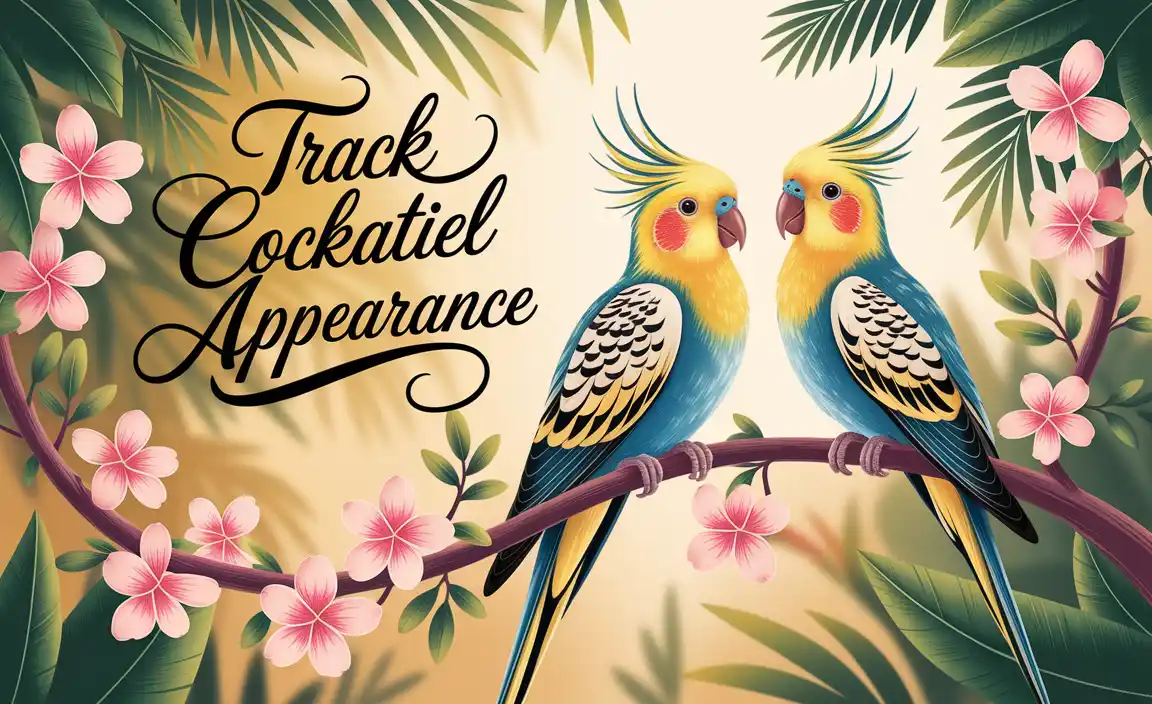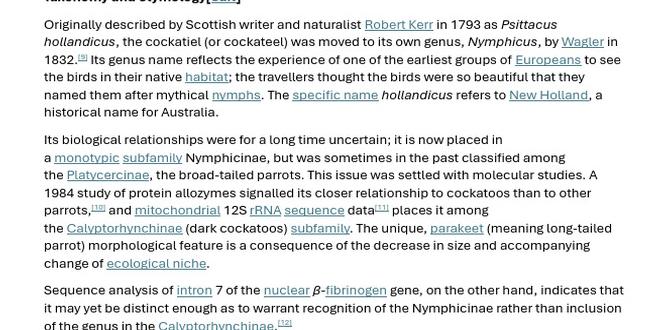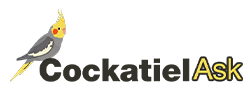Imagine watching a baby cockatiel grow and change every day. Isn’t it fascinating? These colorful birds are wonders of nature. But how do you make sure you remember all the changes in their appearance over time? Documenting their looks can be a fun hobby, like keeping a colorful diary. What if your future self wants to know when your cockatiel got its first yellow feather? Or when its crest grew taller? By noting simple details, you’ll create a time capsule of memories. Did you know cockatiels’ feathers can change before your eyes? Whether you have one cockatiel or many, capturing their transformations can be a delightful journey. Where will your notes take you?

Documenting Cockatiel Appearance Over Time: A Guide

Documenting Cockatiel Appearance Over Time
Curious about how cockatiels change as they age? Recording their unique features can be fun! Start by snapping a picture each month. Notice changes in their feathers and colors. Create a simple journal with these photos. Write down their weight and mood swings too. Did you know male cockatiels can shift in color as they mature? It’s true! Observing this transformation will help you bond more with your feathered friend.
Reasons to Document Cockatiel Appearance
Monitoring health changes. Capturing growth and development.
Ever wished your feathered friend could have a baby album? Well, documenting your cockatiel’s looks can be quite insightful! Think of it as a health journal. By keeping track, you spot problems early, like if Polly gains a bit too much fluff around her tummy. Plus, watching their growth and development is like witnessing nature’s magic. Who knew that your little chirper could turn from a ball of fluff to a majestic feathered wonder? Here’s a peek at the benefits:
| Reason | Benefit |
|---|---|
| Monitoring Health Changes | Spot illnesses early; ensure a vibrant, chirpy life. |
| Capturing Growth | Watch their transformation, age gracefully! |
Essential Tools for Documenting Appearance
Suggested photography equipment. Recommended notetaking methods.
To capture a cockatiel’s charm over time, you might want to unleash your inner photographer first. A smartphone with a good camera or a simple digital camera works wonders. Add a tripod to keep it steady. Now the secret ingredient? Patience. Birds are not the best at selfies!
On the note-taking side, a small journal or a digital note app like Evernote helps log appearances. Detailed notes like feather colors and patterns make a journal or app extra valuable.
| Tool | Purpose |
|---|---|
| Camera | Capture images |
| Tripod | Stabilize shots |
| Journal/App | Record details |
Steps to Document Cockatiel Appearance
Setting up a consistent schedule. Techniques for photographing and recording details.
Keeping track of your cockatiel’s look is like making a feathered scrapbook. Start by picking a day each week, like “Feather Friday,” for a photo shoot. This keeps things regular and fun. Snap pictures with a bright light, so even the smallest feather details shine. Jot down their unique spots or color changes. These little notes are as important as a pirate’s map!
| Step | Action |
|---|---|
| Schedule | Choose a consistent day, like every Friday. |
| Photography | Use natural light for clear photographs. |
| Recording | Note changes in color or patterns. |
According to experts, documenting these changes helps spot health issues early and keeps your memory fresh. Enjoy the process, as it’s both a science and an art. Remember, each picture is part of your bird’s fantastic story!
Tracking Physical Changes and Patterns
Noticing feather coloration and patterns. Identifying physical growth milestones.
As you observe your cockatiel, get ready for some delightful surprises! Watch their feathers transform like a mini rainbow in your living room. Notice new colors and patterns over time. They might even have a fashion show, showcasing fresh shades. Pay attention to growth milestones too. Did your cockatiel grow taller or fluffier? Keep a journal and maybe even a feather album! Here’s a handy little table for tracking changes:
| Date | Feather Color/Pattern | Physical Growth Milestones |
|---|---|---|
| Day 1 | Yellow with gray spots | 8 inches tall |
| Day 30 | More vibrant yellow feathers | Grew a new tail feather |
Using this approach, you’ll see how amazing your feathered friend truly is!
Utilizing Digital Tools and Apps
Best apps for logging data. How to create a digital journal.
Discover the magic of keeping tabs on your cockatiel’s changing looks through nifty digital apps! With so many choices, finding the right one can feel like picking the ripest apple from the tree. Apps like Feathered Friends and Birdie Diary make it easy. They let you record each dazzling detail. To start your digital journal, snap photos and note changes in feathers or color. Soon, you’ll have a feathered fashion catalog of memories.
| App Name | Special Features |
|---|---|
| Feathered Friends | Photo timeline, personalized alerts |
| Birdie Diary | Notes, share options |
Analyzing and Interpreting Documented Data
Recognizing normal versus abnormal changes. Consulting with avian veterinarians for interpretations.
Observing changes in your cockatiel can be like watching a tiny feathered detective story unfold. Noticing what’s normal and what’s not is key. For instance, if your bird is losing feathers, ask yourself: is it a regular molt, or is something fishy? Keep records, maybe even a little birdie diary. For those puzzling changes, seek advice from an avian vet. They’re the Sherlock Holmes of the bird world!
| Change | Normal | Abnormal |
|---|---|---|
| Feather Loss | Seasonal Molting | Sudden Bald Patches |
| Weight | Slight Fluctuations | Dramatic Loss or Gain |
Tips for Effective Documentation
Maintaining consistency in documentation. Engaging friends and community for insights.
Keeping tabs on your feathered friend’s ever-changing style can be fun! To get started, find a cool notebook or app and record details like feather colors and patterns regularly. Consistency is key—think of it as a fashion diary for your cockatiel. Connect with buddies or join online groups to share notes and gather fresh ideas. They might provide insights like, “Does your bird’s tuft look sleeker than last week?” Always be ready for quirky revelations!
| Step | Description |
|---|---|
| Consistency | Document regularly to maintain an accurate record. |
| Community Input | Engage with others for different perspectives and tips. |
Conclusion
In documenting your cockatiel’s appearance over time, photos are vital. Capture its growth and changes regularly. Note any color or size differences in a journal. This helps you understand health and development better. Keep a monthly record for clearer comparisons. Explore online guides for detailed advice on avian care and documentation techniques.
FAQs
What Tools And Methods Can Be Used To Accurately Document The Physical Changes In A Cockatiel’S Appearance Over Time?
To keep track of how a cockatiel changes over time, you can use a camera to take photos. Label the pictures with dates to remember when you took them. You can also use a notebook to write down changes you see, like new colors or feathers. Measuring tape helps track the length of their wings or tail. Doing this helps you see how your pet grows and changes!
How Frequently Should I Take Photographs Or Make Notes To Effectively Track My Cockatiel’S Appearance Development?
You should take pictures and make notes about your cockatiel every week. This way, you can easily see how it grows and changes. Use a notebook to write what you notice. With weekly updates, you’ll have a great record of your bird’s development.
What Specific Physical Attributes Should Be Monitored When Documenting The Changes In A Cockatiel’S Appearance?
When checking how a cockatiel looks, focus on its feathers, beak, and eyes. Notice if the feathers are smooth or messy and if any are missing. Look at the beak’s color and shape—it should be smooth and not cracked. Make sure the eyes are bright and clear. Also, check the feet to see if they look smooth and healthy.
How Can I Create A Systematic And Organized Record-Keeping Method For Tracking My Cockatiel’S Physical Changes?
To track your cockatiel’s changes, get a notebook. Write down the date each time you notice something new. You can draw pictures of your cockatiel, too. Make a checklist for things like new feathers or weight changes. Look at your notes often to see how your bird grows.
What Are Some Common Signs Of Health Issues In Cockatiels That I Should Be Attentive To When Documenting Their Appearance?
Look for cockatiels with puffy or ruffled feathers. This can mean they are sick. Check if their eyes are watery or crusty. Watch out for changes in their droppings or if they are not as active. If your cockatiel isn’t chirping or eating, it might need a vet.
